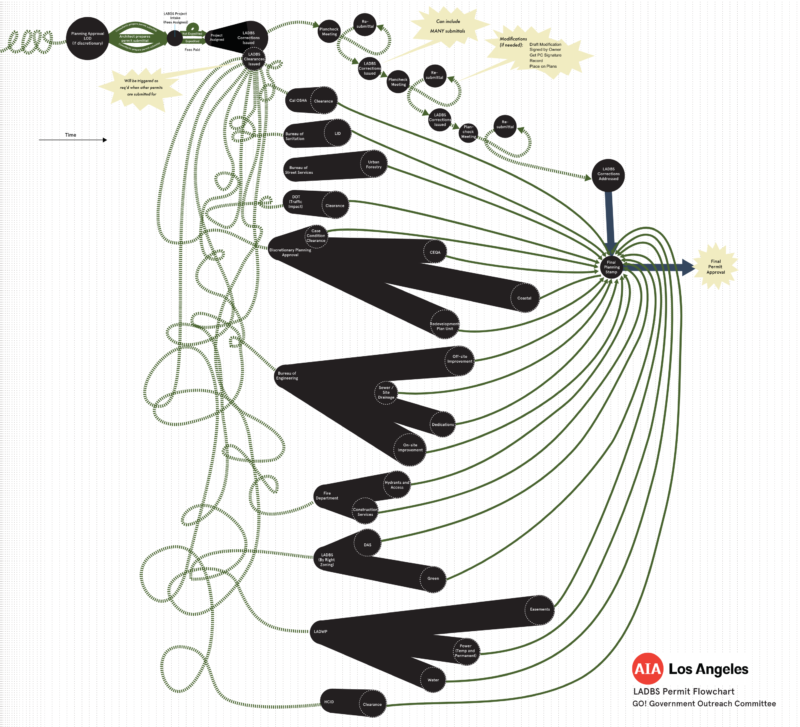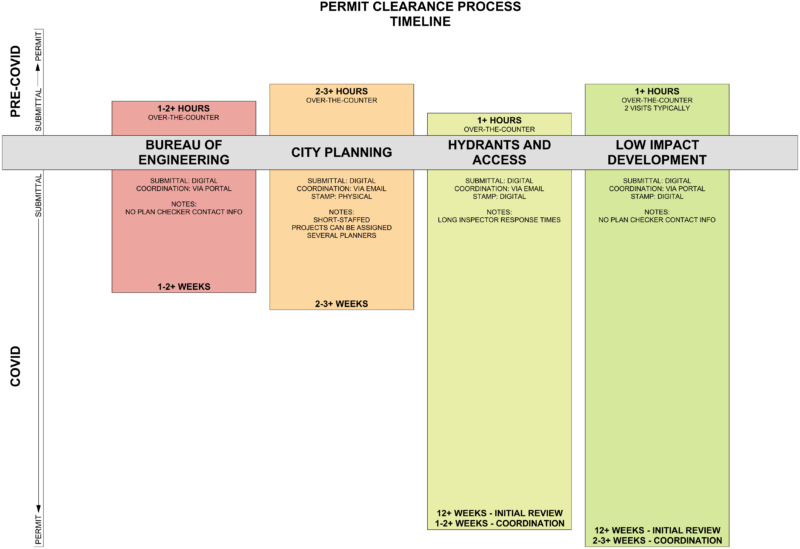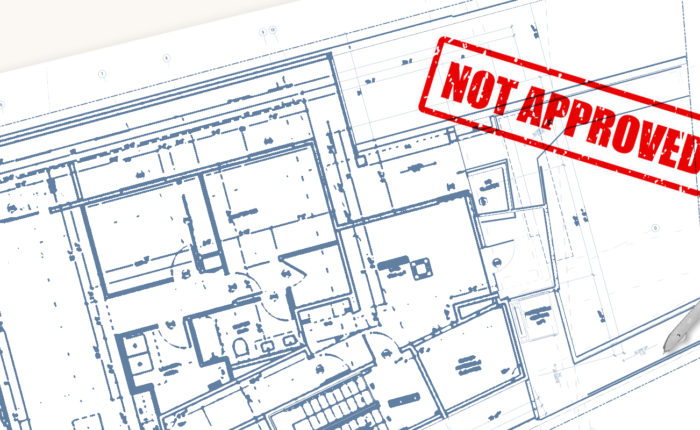You know it’s bad when we get an email from a fellow architect, developer or client with the subject line “Please help!” and find they are attempting to navigate the convoluted City of Los Angeles’ permitting process. While COVID has rendered many business processes more difficult or even obsolete, residents are questioning how to get anything permitted in a timely manner in the City of Los Angeles these days.
To that end, we’d like to enlighten you on why projects are taking exponentially longer in plan check. The upside? Tracy has used this extra time waiting for the city to respond to wisely create some unique craft cocktails! (JK but it’s definitely one way to ease the frustration). Scroll to the end of this blog for a city permitting inspired cocktail that, as you’ve guessed, takes awhile to make! The irony is not lost on us.
Our two-part series will give you an overview of the current “system” (compared with the old), including approximate timelines, how these new timelines affect development and undertakings that may help resolve at least some of these issues. Plus, we’ll share a secret weapon that may make the process MUCH easier. As a note, the city is well aware of the COVID impacts on the permit process and we have confidence that they are working to address some of these issues.
Long term side-effects
 Ever heard the phrase the “straw that broke the camel’s back”? These delays and inconsistencies affect each and every one of us. It seems that while the rest of the world has been forced to find a way to operate normally, the city has essentially closed their doors to the public and cut off 90% of communication.
Ever heard the phrase the “straw that broke the camel’s back”? These delays and inconsistencies affect each and every one of us. It seems that while the rest of the world has been forced to find a way to operate normally, the city has essentially closed their doors to the public and cut off 90% of communication.
Many architect-based forums ooze with similar frustrations and emphasize that small businesses like ours are the ones that often take the brunt. Small architecture firms survive by keeping projects moving and collecting our final payments which allows us to take on new projects. However, when the amount of work quadruples for what was originally budgeted and projects linger months and months longer than anticipated, that directly affects how we function as a business. As you can see in the frustration/time continuum shown above, not only do these delays negatively impact our budgets, schedules, and increase client frustrations, they also seriously kill our morale and have encouraged many to leave the design industry altogether. What’s the point of a builder if nothing can be built?
Meanwhile, on the client side, the delays in reviews have wreaked havoc on construction financing and any sort of pro forma that was created with a feasible schedule just two years ago. City fees have increased, architecture fees go up (because, well, it takes four times as long to process) – fees which in turn get passed on to the end user: the homeowner. You don’t have to stretch your imagination too far to answer “Why is housing so expensive in LA?”
Here is a diagram the local Los Angeles AIA GO! Committee has created to depict all the various departments/clearances (black nodes) and the path of least resistance (green lines). Check out the full-size version here.

Surely it’s not that bad…
It is. Trust us. Gone are the days of a four-month permit process. It now takes YEARS. Ok fine, maybe we’re exaggerating a little bit…but the key here is that it’s completely unpredictable. Processes that used to be an over-the-counter clearance are now 12+ week digital reviews with little consistency across the various plan checkers. We might have been working with the city for six months only to have a new requirement pop up, or work with departments for so long that staff have left or been reassigned and the new person requires a whole different set of criteria that was never previously mentioned. Keep in mind, we are experienced in processing projects through permitting — IMAGINE IF YOU DIDN’T ALREADY KNOW THE PROCESS!!

To start, let’s review the process pre-2020 for an average project:
- Submit for plan check in person at the counter (backroom plan check 8-10 weeks)
- Receive comments back along with a set of clearances
- Process clearances with the various departments (approx. 4-6 weeks depending on complexity)
- Bureau of Engineering (BOE): most done over-the-counter (fees, sewer availability, etc.) and only a few rare clearances would be handled by different sub-departments, such as B-Permit, Revocable Permits, etc.
- City Planning: most done over-the-counter unless they involved entitlements, which occasionally triggered an appointment
- Hydrants and Access/Fire Life Safety Review: typically over-the-counter
- Low Impact Development (LID)/Bureau of Sanitation: over-the-counter clearance for single family projects and occasionally up to 4 units
- Any restamps needed were usually done over-the-counter
- Follow up with an in-person plan check meeting to go over outstanding comments. Occasionally a few comments still need addressing or fixing, so a second verification meeting was set for a couple weeks later to have the permit ready to issue.
NOTE: while it was a good workout…er, we mean pain…lugging around three full sets of drawings to the various counters for stamps, it could usually be done over a couple days’ time and was relatively easy to keep track of all the stamps on a final set(s) of plans.
Now, let’s compare to the 2022 process:
- Submit for plan check by dropping plans off in a bin with an application. After 2-3 days, and if all documents were provided, receive a link to pay. Pay via online portal. (backroom plan check 8-10 weeks)
- What used to take a couple hours to submit plans, now takes a couple days…just to submit
- Receive comments back along with a set of clearances
- Process clearances with the various departments (approx. 4-5+ months depending on complexity)
- Bureau of Engineering (BOE): most done via an online portal. Once a request is submitted via the portal, BOE tends to respond in 2-3 days EACH TIME. If the request is not clear or all items are not addressed by either party, you must send follow-up requests and each time taking 2-3 days for review.
- Change of Timeline: from over-the-counter to 1-2+ weeks overall
- Pros: Submittals and requests are all done digitally, Heads are aware of the issues and diligently working to improve the process
- Cons: There is no way to escalate an issue to a supervisor and you tend to get the same person. Some staff are more experienced on different topics and there is no way to request or switch responders. No personal emails or phone numbers are given so there’s no human to explain a complex issue to.
- City Planning: all done digitally via email (2-3 weeks pending complexity). What used to take a matter of hours now takes 1-2+ weeks, best case scenario, to finalize all basic planning clearances.
- Change of Timeline: from over-the-counter to 2-3+ weeks overall for a basic project, entitlement projects involving more covenants/document reviews can take 4+ weeks to finalize clearance review
- Pros: Submittals and reviews are mostly done digitally (stamps still done physically), you have email and phone number for the reviewer
- Cons: City Planning is short-staffed and we’ve experienced having several projects get passed to several planners, each requesting different items for the review. Coordination of covenant signatures and stamps are still done physically via drop-off bins and take several days each direction as the documents go through “quarantine”.
- Restamps: Must coordinate drop-off with staff assigned to project, and to make its way through the drop-off bin process takes several days minimum
- Hydrants and Access/Fire Life Safety Review: all done digitally via portal and email – submitted via a portal and then coordinated via email once assigned to an inspector. Along with LID below, this is the biggest shocker to the schedule.
- Change of Timeline: from over-the-counter to 12+ weeks for initial review (!!!!!), and then 1-2+ weeks coordinating any adjustments to the plan assuming you have an inspector that responds to emails in a timely manner
- Pros: Submittals and reviews are done completely digitally (including stamps); you have an email and phone number for the inspector
- Cons: All I can ask is — how did a simple, over-the-counter review turn into 12 weeks?? Also, communication is not a high priority of some inspectors and it can take MONTHS to get a response from some
- Restamps: Can coordinate this digitally (but this means plans must be printed and collated into any physical sets, and then get additional restamps on those same sheets)
- LID/Bureau of Sanitation: all done digitally via portal
- Change of Timeline: from over-the-counter to 10-12+ weeks for initial review (!!!!!), and then 2-3+ weeks coordinating any adjustments to the plan and covenant signatures, etc. Some plan checkers take 1+ week to respond to anything submitted.
- Pros: Submittals and reviews are done completely digitally (including stamps)
- Cons: There is no way to escalate an issue to a supervisor. No personal emails or phone numbers are given; there’s no human to explain a complex issue to. There is no way to ask questions unless the plan checker opens the portal for re-submissions. Coordination of covenant signatures are done physically via drop-off bins and take several days each direction as the documents go through “quarantine”.
- Restamps: Can coordinate this digitally (but this means plans must be printed and collated into any physical sets, and then get additional restamps on those same sheets)
- Bureau of Engineering (BOE): most done via an online portal. Once a request is submitted via the portal, BOE tends to respond in 2-3 days EACH TIME. If the request is not clear or all items are not addressed by either party, you must send follow-up requests and each time taking 2-3 days for review.
NOTE: Where we used to cart around physical drawings to the various counters and get them all done in a day or two, we now have to coordinate stamps (some digital, some physical) with each department via the bin drop-off process (approx. 2-3 days turnaround each time for each department). This alone can take months to get one department at a time to review/approve things, and once a small change is required, we must go back to square one with restamps/re-reviews.
Check out the diagram below for a few REAL examples of project clearances and the type of coordination/communication that has become common with so many different departments.

Additional hiccups we’ve been encountering recently:
- Many city employees are working remotely and are incredibly hard to reach (and that’s IF we know who to contact). As we noted in the timelines above, some departments hide behind a digital veil and we have no idea who we’re working with, and thus, unsure of whom to contact. We’ve had instances where it took a plan checker over four months to provide a simple email response after the issue was escalated to several different supervisors.
- Finding the most recent supervisor list is like finding a needle in a haystack. Many online directories are out of date, if you can find one at all. We’ll share our best attempt at collecting the latest lists in part two of this blog.
- Lack of consistency among reviewers/plan checkers. Every time we submit our plans, we often encounter new interpretations of code or issues being brought up that had never been discussed on the dozens of previous projects, or even discussed earlier in the SAME project.
You’ve made it!
If you’ve made it to the end of Part 1, congrats! You’re likely in need of a therapy session or one of Tracy’s craft cocktails – is it 5 o’clock yet?
We now gladly introduce you to…Marco Polo: A bit unexpected, a bit strong, and will provide the appropriate time to reflect on the process before the burn hits. Sound familiar?

Stay tuned for Part 2 – where we’ll give you an overview of how to make the most of this process and resolve at least some of these issues. Plus, we’ll share a secret weapon that may make the process MUCH easier.
Of course, we’d love to hear about your experiences – especially if you have any tips to share that may make others’ experiences less exasperating, or ideas on how to improve the process! We will pass on any relevant suggestions to the appropriate city departments.



